
D. Nuno Álvares Pereira, O. Carm. was a Portuguese general of great success who had a decisive role in the 1383-1385 Crisis that assured Portugal's independence from Castile. He later became a mystic and was beatified by Pope Benedict XV, in 1918, and canonised by Pope Benedict XVI in 2009.
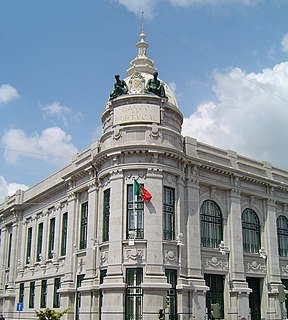
Braga is a city and a municipality capital of the northwestern Portuguese district of Braga and of the historical and cultural Minho Province. The city has a resident population of 193,333 inhabitants, representing the seventh largest municipality in Portugal. Its area is 183.40 km2. Its agglomerated urban area extends from the Cávado River to the Este River. It is the third-largest urban centre in Portugal.

Angra do Heroísmo, or simply Angra, is a city and municipality on Terceira Island, Portugal, and one of the three capital cities of the Azores. Founded in 1478, Angra was historically the most important city in the Azores, as seat of the Bishop of the Azores, government entities, and having previously served as the capital city of Portugal during the Liberal Wars. The population in 2011 was 35,402, in an area of 239.00 km². It was classified as a World Heritage site by UNESCO in 1983.

Angústias is one of the three freguesia that comprise the urban area of the city of Horta, on the island of Faial in the Portuguese archipelago of the Azores. This is an economically active, densely populated area. The population in 2011 was 2,418, in an area of 3.79 km2. Due to its commercial nature, the parish is one of the island's primary destinations for tourism, due to the concentration of historical sights and shopping. It contains the localities Caminho do Meio, Courelas, Pasteleiro, Port Pim, Termo da Igreja and Vigia.

Vila Franca do Campo is a town and municipality in the southern part of the island of São Miguel in the Portuguese Autonomous Region of the Azores. The population of the municipality was 11,229 in 2011, in an area of 77.97 km². The town proper, which incorporates the urbanized parishes São Miguel and São Pedro, has 4100 inhabitants.
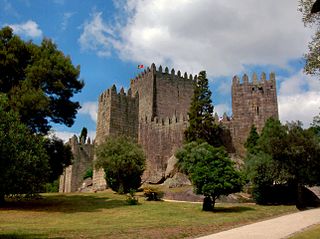
The Castle of Guimarães, is the principal medieval castle in the municipality Guimarães, in the northern region of Portugal. It was built under the orders of Mumadona Dias in the 10th century to defend the monastery from attacks by Moors and Norsemen.
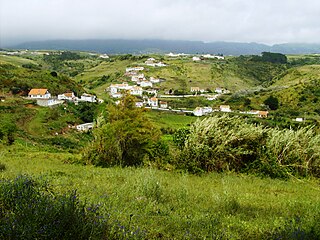
Vila do Porto is a civil parish in the municipality of Vila do Porto, located on the island of Santa Maria, in the Portuguese autonomous region of Azores. It is the southernmost and easternmost parish in the archipelago of Azores. The population in 2011 was 3,119, in an area of 25.55 km².

Álvaro Gonçalves Pereira, Prior of Crato, was born to Gonçalo (Gonçalves) Pereira, 97th Archbishop of Braga (1326-1349) and Teresa Peres Vilarinho. At a very young age, he entered the Order of St. John of the Hospitallers. At Rhodes, at the time seat of the Order, he fought the Turks in the galleys of the Hospitallers so proving his worth that the Grand Master made him Prior of the Hospitallers in Portugal. There he founded the Castle of Amieira, the palaces of Bonjardim and the Monastery of Flor da Rosa, near Crato, the seat of the Order in Portugal. He administered the Order with great zeal and won a brilliant victory at Salado. He was one of the eminent figures of the reigns of Kings Afonso IV, Peter I and Ferdinand I. He died at an advanced age ca 1375. He was the father of the Constable of Portugal, Nuno Álvares Pereira.

The Monastery of Rates was a Benedictine monastery located in the parish of Rates in the municipality of Póvoa de Varzim, in Portugal. The part of the monastery that has survived to this day is the bell-tower and, most importantly, the Church dedicated to St Peter of Rates, mostly known as Romanesque Church of Rates, which is a national monument since 1910. Reconstruction of the church began at the turn of the 11th to the 12th century, turning it into one of the oldest extant Romanesque churches in Portugal.

The Castle of Belver is a Portuguese castle in the civil parish of Belver, municipality of Gavião, district of Portalegre, in central Portugal.
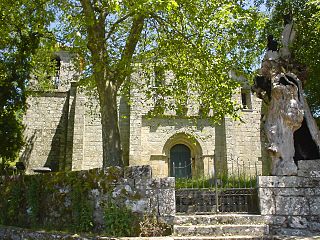
The Church of Santo André is a Romanesque and Baroque era Portuguese religious building located in the civil parish of Fiães, municipality of Melgaço, in the northern Portuguese district of Viana do Castelo.
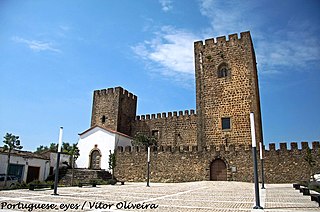
The Amieira do Tejo Castle is a Portuguese castle in the civil parish of Amieira do Tejo, municipality of Nisa, in the antique district of Portalegre, approximately 200 kilometres from the city of Lisbon
The Prior of Crato, was the traditional title given to the head of the Order of the Knights of St. John of Jerusalem (Hospitaller) in Portugal. It is a reference to the domains of the order around Crato, Portugal.

The architecture of Póvoa de Varzim, in Portugal, demonstrates a broad variety of architectural styles over its thousand years of history. 11th-century Romanesque, 16th-century Mannerism, 18th-century Baroque, late 18th-century neoclassicism, early 20th-century Portuguese modernism and late 20th- to early 21st-century contemporary architectural styles and more are all represented in Póvoa de Varzim. As a whole it represents a rich eclectic tradition and innovation shaped by the people, their beliefs and economy.
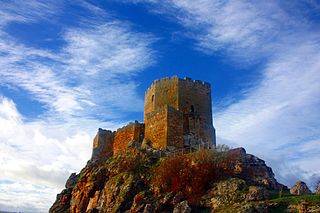
The Castle of Algoso is a medieval castle in the civil parish of Algoso, Campo de Víboras e Uva, municipality of Vimioso, in the Portuguese district of Bragança. The castle of Algoso is one of the most important medieval fortifications in the eastern Trás-os-montes, related with the battles of Leonese succession, the tentative policies of the independent Portuguese monarch and the important religious commandery of the Knights Hospitaller that established their roots in 1224.

The Castle of Penedono is a medieval castle located in the civil parish of Penedono e Granja, in the municipality of Penedono, Portuguese district of Viseu.

The Castle of Óbidos is a well-preserved medieval castle located in the civil parish of Santa Maria, São Pedro e Sobral da Lagoa, in the municipality of Óbidos, Portuguese District of Leiria.

The Castle of Redondos is a medieval castle located in the civil parish of Buarcos, in the municipality of Figueira da Foz, Portuguese Coimbra.
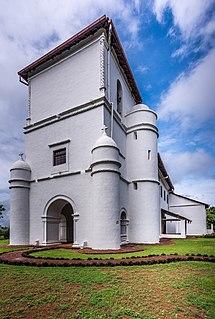
The Church of Our Lady of the Rosary is a Catholic church built between 1544 and 1547, in Old Goa, State of Goa, India. This church is part of the collection belonging to the World Heritage Site of churches and convents of Goa.

The Church of Our Lady of the Angels, more commonly known simply as Igreja dos Anjos, is a Roman Catholic parish church located in Lisbon, Portugal.




















